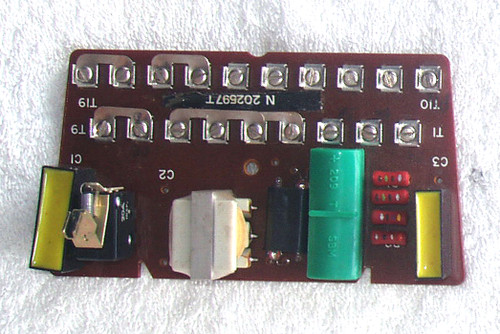HISTORY:
At the beginning of my career in electronics, many moons ago, I worked in the telephony industry in NZ. After a few years in the tech side (Fault Control Centre & Exchange techie) I could see the rapid advancement of technology would mean the end of my job as I knew it and left that industry.
However the flame has always burned for all things relating to telephones, both at the subscriber, exchange and all things in between (even loading coils!) So whenever I crossed paths with some telephone equipment, I 'collected' it.
The last few years have been cleanup time with a LOT of the gear finding new owners and now I am approaching the end of my telephone gear collection but I still find some 'dribs n drabs' of equipment - this subscriber instrument is one of those items.
Before it underwent 'the operation' on the workshop bench, this was a type 746 subscriber telephone BUT the rotary dial and case had already been donated to other equipment and I was now left with the 'carcass' showing in one of the phototgraphs.
To the best of my knowledge, this would appear to be a British made instrument not local to Australia or NZ although I think STC Australia had a hand in similar equipment. In my description of this telephone component, I provide all of the identification markings I can see so that you can make sure this component will suit your own telephone.
British Post Office liked to name their telephones at this time and this Brown cased 746 was called the "Yeoman"
Obviously this component is aimed at those who share a similar passion for those good ol' days of 2 wire lines, A & B wires, 'boxes' and 'cabinets' and who could forget those aerial lines (meaning wires up in the air between poles) with the glass or porcelain insulators? In the exchange, that never ending sound of the uniselectors and switches moving all the time, especially when the local radio station had a 'call in' competition ... Ah ... those were the days
Enough of the background to this component, time to tell you all about it ...
If this component from the 746 instrument isn't what you are looking for ... try searching HERE
STC (STANDARD TELEPHONE & CABLES) UK - Subscriber Telephone Component
Removed from what was left of a BPO type 746 instrument (see photograph prior to the 'operation')
Component: Bell Ringer
As used in the type 746 subscriber telephone
Part #: N104014DJ
Also printed into the base of the frame
PATENT No. UK 1072216
N9268C 3T
Single coil, 1000 Ohm, with a long metal 'finger' that vibrates against both bell gongs as the finger sits in between them. Adjustment of the ringing sound can be made by rotating the bell gong(s), changing the distance between the ringer finger and each gong.
Uses two screws for mounting and these are supplied
Weight: 115g
TESTING:
This bell ringer is fully functional, tested prior to the telephone being dismantled (needed to wire into the instrument an ad-hoc dial for testing) vibrates it's heart out when receiving the 80V AC ringing via the main capacitor (1.8uF) on the PCB.
Vintage Technical Useless Information ...
Did you know that it was this 1.8uF capacitor and the charge/discharge 'kick' that was one of the main criteria used for line testing of subscriber lines? A 'good' 2 wire line through to the telephone instrument would produce a nice 'kick' when the test desk keys were operated (reversing the line polarity and so charging/discharging the 1.8uF capacitor at the telephone) No kick often indicated an open circuit (call a 'dis' = disconnection). Reduced or no 'kicks' were often caused by shorts or poor line insulation (leakage, often caused by water) All these tests were made remotely from the subscriber telephone, often many tens of kilometres away - the test desk accessing every single subscriber line through exchange "test final switches" on the old SXS system.
COSMETIC CONDITION:
USED
CLEAN
NO damage to the complete assembly
Flying leads (Blue) with eye connectors (for the PCB) are also in great condition
Both of the mounting screws are supplied.
I have now placed this bell ringer (along with the screws) into a sealed clear plastic packet, while it waits to make another telephone 'sing'









